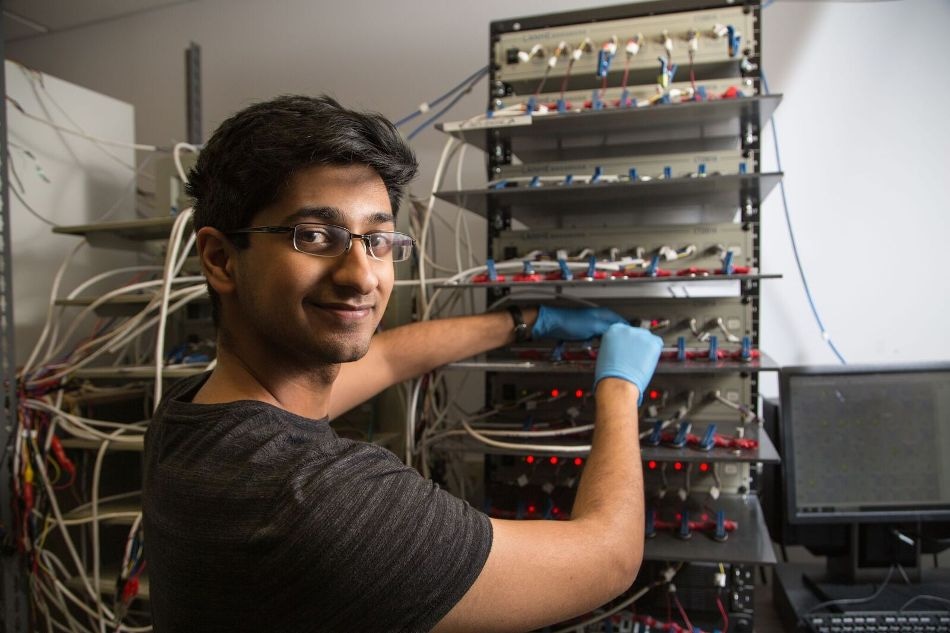Apr 21 2017
 Karun Kumar Rao, a chemical engineering graduate student in the Cullen College of Engineering, has earned a NASA research fellowship for his work to develop a safer battery. (Credit: University of Houston)
Karun Kumar Rao, a chemical engineering graduate student in the Cullen College of Engineering, has earned a NASA research fellowship for his work to develop a safer battery. (Credit: University of Houston)
The scientific community is constantly in the pursuit of a battery that is safer, lighter, and longer lasting for a range of applications from portable electronics to transportation and launching space satellites.
Karun Kumar Rao, a chemical engineering graduate student from the University of Houston has been awarded a NASA Space Technology Research Fellowship to identify new materials for advanced batteries. He will work with NASA researchers, as well as with two mentors at UH to identify new materials that can be employed for a solid-state electrolyte in a lithium battery.
Lars Grabow, assistant professor of chemical and biomolecular engineering, and Yan Yao, assistant professor of computer and electrical engineering, will work with Rao on the project.
Rao got his undergraduate degree in chemical engineering at Case Western Reserve University, where he was involved in a research involving electrochemistry. He co-authored three academic publications as an undergraduate.
Expanding his work in energy was the next rational step for him to take.
The ease of energy generation and storage has a huge influence on the quality of everyone’s life. Everything about energy is really vital to our society, and with batteries, even incremental improvements can have big impacts.
Karun Kumar Rao, Chemical Engineering Graduate Student, University of Houston
His research will involve developing a solid-state electrolyte for advanced lithium batteries. An organic liquid electrolyte is used in conventional lithium ion batteries.
That is effective but also can be unsafe, Rao said, as seen in the case of the recent battery fires involving battery-operated hoverboards and Samsung mobile phones.
Ceramic solid-state electrolyte materials are not flammable but are less effective. Rao recommended using an integrated computational and experimental approach to study a group of crystalline solid state electrolytes for a lithium battery that can balance high performance and safety. Computational models will allow for fast screening of different structures, materials, and geometries and will be tested and guided by experimental data gathered via electrochemical characterization and battery testing, he said.
This new project relies upon earlier collaborations between Grabow and Yao. Grabow has experience in modeling and guessing material properties using high-performance computing infrastructure, while Yao designs advanced materials for several applications for batteries and energy storage.
Grabow said he was instantly excited about the project. “Adding the computational design of novel battery materials to my group’s research portfolio has been a long-standing goal,” he said. “Being able to benefit from Karun and Yan’s expertise in this area will greatly reduce the steep learning curve.”
Yao said Rao’s selection for the NASA fellowship and the chance to work more closely with Grabow offer unique opportunities.
“In the past, the development of safe and high-energy batteries in my group was made largely through experimental approaches, often by trial and error and largely depending on our experience and intuition,” Yao said. “Computation has now become an important tool by providing insights into fundamental processes that are not otherwise accessible, as well as quantitative comparisons with experimental results.”
Rao integrates both techniques, which Yao said is uncommon in the battery field.
The research could pave the way to batteries that are more powerful but weigh lesser. That would have significant applications for space technology, from telescopes and satellites to rovers and the international space station.
They would be safer, too, Rao said.
Everywhere you look, people need better batteries that are safe to use. Solid-state batteries can potentially enable more advanced mobile devices and electronics but we’re not there yet.
Karun Kumar Rao, Chemical Engineering Graduate Student, University of Houston